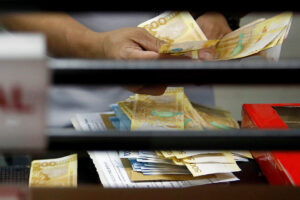




Quarterly Economic Growth Release: More BSP cuts to come
 DOWNLOAD
DOWNLOAD

Monthly Economic Update: Fed catches up
 DOWNLOAD
DOWNLOAD

Inflation Update: Steady and mellow
 DOWNLOAD
DOWNLOAD


Banks’ bad loan ratio steady in July

THE BANKING INDUSTRY’S nonperforming loan (NPL) ratio remained steady in July despite high borrowing costs and elevated inflation.
Based on data from the Bangko Sentral ng Pilipinas (BSP), the Philippine banking sector’s gross NPL ratio stood at 3.43% as of end-July, unchanged from end-June. It is also lower compared with the 3.57% NPL ratio in July 2022.
The July ratio was the lowest in three months or since 3.41% in April. The NPL ratio was on the rise in the first five months of the year to 3.46% as of end-May but declined to 3.43% in June.
Bad loans rose by 4.5% to PHP 439.328 billion as of July from PHP 420.255 billion a year earlier. It also inched up by 0.68% from PHP 436.371 billion seen as of end-June.
Meanwhile, banks’ total loan portfolio increased by 8.8% to PHP 12.81 trillion as of end-July from PHP 11.77 trillion a year ago. It was also up by 0.6% from PHP 12.73 trillion at end-June.
Loans are considered nonperforming once they remain unpaid for at least 90 days after the due date. They are deemed as risk assets given borrowers are unlikely to settle such loans.
“We’re pleased to see that despite slower economic growth in the second quarter, still elevated inflation, and sustained rapid expansion in consumer credit growth, that overall industry bad loan ratios continue to be muted,” Bank of the Philippine Islands Lead Economist Emilio S. Neri, Jr. said.
The Philippines’ gross domestic product (GDP) expanded by 4.3% in the second quarter, weaker than 6.4% in the first quarter and 7.5% in the second quarter a year ago. In the first half, GDP growth averaged 5.3%, still below the government’s 6-7% target for 2023.
Headline inflation averaged 6.8% in the first seven months of the year. While inflation eased to 4.7% in July, this still marked the 16th consecutive month that it surpassed the BSP’s 2-4% target range.
To tame inflation, the BSP has raised rates by 425 basis points from May 2022 to March 2023, bringing the benchmark interest rate to a near 16-year high of 6.25%.
Based on BSP data, banks’ past due loans increased by 7.5% to PHP 528.404 billion as of end-July from PHP 491.289 billion a year ago. This brought the past due loans’ share in total loans to 4.12% as of July, from 4.17% a year ago.
Restructured loans fell by 11.1% to PHP 304.175 billion from PHP 341.972 billion in the same month in 2022. These accounted for 2.37% of the banking system’s loan portfolio.
Meanwhile, banks continued to boost their loan loss reserves to PHP 449.748 billion in July from PHP 416.733 billion a year ago. This brought the loan loss reserves to the total loan portfolio ratio to 3.51% from 3.54% a year earlier.
The industry’s NPL coverage ratio also improved to 102.37% from 99.16% the year before.
Separate BSP data showed outstanding loans of universal and commercial banks rose by 7.7% to PHP 11 trillion in July, slower than the 7.8% growth a month prior.
Consumer credit jumped by 22.6% to PHP 1.15 trillion in July from PHP 934.7 billion a year ago.
“We’re hoping that sustained improvements in Philippine employment metrics combined with the public sector’s commitment to step up on the execution of their spending programs that in the second half, NPL ratios will continue to remain subdued,” Mr. Neri said.
The government has ordered departments to come up with catch-up spending plans to address underspending in the first half. — Keisha B. Ta-asan
This article originally appeared on bworldonline.com





 By BusinessWorld
By BusinessWorld